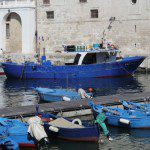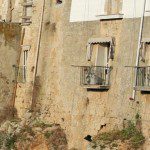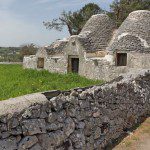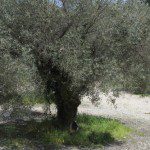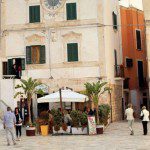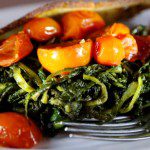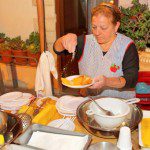Stuart Forster explores the traditional, cone-shaped trulli and walled farmhouses of Apulia while being charmed by the laidback, understated nature of the southern Italian region.
[vc_row][vc_column width=”1/4″][vc_separator color=”black” border_width=”10″][vc_custom_heading text=”Italy”][vc_separator color=”black” border_width=”2″][vc_widget_sidebar sidebar_id=”sidebar-page”][/vc_column][vc_column width=”3/4″][vc_column_text]
- Blue fishing boats in the harbour of Monopoli
- Clifftop houses overlook the cove at Polignano a Mare, on the Adriatic Sea
Stuart Forster explores the traditional, cone-shaped trulli and walled farmhouses of Apulia while being charmed by the laidback, understated nature of the southern Italian region.
Ask travellers about the destinations they aspire to travel to within Italy and more often than not their answers will include famous, romantic spots such as Tuscany, Venice and Rome. This year, thanks to the world fair, Expo Milano 2015, you’re also likely to hear Milan mentioned. The Apulia region – Puglia in Italian – features surprisingly infrequently though it’s well worth a visit.
Maybe that silence is by design? Perhaps those in the know don’t want their favourite Apulian bolthole to become overrun and thus lose its charm? If you’re perusing a map of Italy and want to locate this sun-kissed region, you can locate Apulia around the stiletto heel that juts down from the long, perennially fashionable boot to be washed by the waters of both the Mediterranean and Adriatic Seas. Locals swear it’s possible to enjoy a morning on the beach on one coast before hopping into a car and driving the short distance for an afternoon relaxing on one of the beaches on the other.
For many visitors it’s the delicious yet healthy regional cuisine that keeps drawing them back to Apulia. The region’s long hours of sunlight results in crops of fruit and vegetables singing with flavour. Add fresh fish, landed daily at attractive harbours such as Monopoli, Gallipoli and Giovanazzo, and Apulian chefs can soon whip up a host of tasty dishes. Head inland and you’ll find cheeses such as burrata and mozzarella among the antipasti served with aperitifs. You can also pick up hearty, carefully seasoned meat products such as Capocollo, a speciality of the small town of Martina Franca.
On the streets of Bari Vecchia, the medieval town at the heart of the regional capital, Bari, you can stroll between a host of unpretentious, welcoming businesses showcasing the region’s cuisine. At Panificio Fiore (Strada Palazzo di Citta 38) try a slice of freshly baked focaccia – tomato and olive-topped bread that’s best eaten while still warm from the bakery’s wood-fired oven. Head to any of the squares that open up off the Old Town’s narrow lanes and you’re likely to see dozens of women sitting outside of their houses making orecchiette, meaning ‘little ears’, the pasta that all Italians associate with this region.
For a few Euros a handful of the women will cook up a plate of their pasta and serve it with tomatoes, anchovies and the leaves of a green, broccoli-like vegetable known locally as cime di rapa. Of course you can dine at quality establishments such as Black and White (Piazza Mercantile 77) or Restaurant Glamour (Via Sagarriga Visconti 3) but eating street food is part of Bari’s charm and a must-do experience for any foodie looking to expand their knowledge of the region. Locals will tell you to try a plate of sgagliozze, deep-fried polenta strewn with salt, a filling and no-nonsense dish – depending on the time of day it will give you the energy for sightseeing or a boost to carry on dancing.
Staying at the VOI Oriente Hotel (voihotels.com) places you close to the Teatro Petruzzelli and within easy walking distance of the waterfront and city centre. The 75-room hotel has a rooftop garden that proves a fine spot for socialising over sundowners.
While you’re in Bari don’t pass on the opportunity to view the Basilica of St Nicholas, the medieval landmark and pilgrimage site housing the remains of the Bishop of Myra, the man closely associated with the legend of Santa Claus. The building bears some fine examples of stone sculpture and is used by Roman Catholics as well as Orthodox Christians. If you enjoy gourmet food, schedule a couple of hours to browse the shelves of Eataly (Fiera del Levante Lungomare Starita 4). The vast, beautifully presented store, dining venue and cookery hub stands by the seafront promenade that was developed during the days of Benito Mussolini’s rule.
- A smiling lady outside of a trullo in Alberobello
- A trullo in rural Apulia
- An olive tree in a grove at Alberobello
- An ox sculpture on St Nicholas Basilica in Bari
The region’s deep red wine, Primitivo, may not be regarded as one of the world’s finest but when you’re sat outdoors in an Apulian restaurant it slips down remarkably well and proves a good match to many dishes. If you’re a fan of whites, don’t miss out on the experience of pairing a glass of Malvasia Bianca with seafood. Like any wine producing region, the produce from the best estates is in high demand and only a fraction gets exported. There are certainly some good, underrated wines to be had. Ask your waiter for recommendations and you’re unlikely to be disappointed.
If your pallet is used to gourmet flavours be sure to taste a selection of the olive oils produced in Apulia. Over the centuries the cropping and care of age-gnarled trees has become a skill passed from generation to generation of olive grower. Some of the groves hold trees estimated to be more than a thousand years old. Distinguished by the prodigious girth of their trunks, they continue to produce an annual crop of fruit. Olive oils such as Tre Colline, from the Masseria il Frantoio, and Torrente Locone are rich in antioxidants and flavour. Additionally, as you stroll through the streets of towns such as Taranto, Trani and Ostuni, famed for its white houses, you’ll see stores selling olive-based soaps and skincare products.
Arguably the best-known location in the region is the Castel del Monte, a hilltop, octagonal castle dating from the 1240s. It was constructed on the orders of the Holy Roman Emperor, Frederick II. How it was used in its early years is shrouded in mystery. Some people believe the castle was built to be an observatory, others question whether the monarch ever set foot in the building. Nonetheless, it’s the region’s key landmark and appears on Italy’s one cent coins. It has become a UNESCO World Heritage Site and provides fine views over the surrounding landscape.
Increasingly, Apulia is a region becoming known for its broad range of agrotourism offerings, giving people opportunities to relax in a rural setting and enjoy traditional foodstuffs. Farming has long been important here. For many years masserias – farmhouses with walled enclosures – provided security to people working on the estates in the event of raids. Stables, grain stores and farmhouses arbeing converted into upscale accommodation with rustic charm.
Il Pino Grande (ilpinogrande.it) is located a five-minute drive from Castel del Monte and has spacious rooms. Even if you choose to stay elsewhere it’s worth swinging by to taste cuisine prepared by chef Giovanni Burdi. The devotee of the slow food movement makes use of wild ingredients to showcase his creative take on traditional Apulian dishes.
- The piazza in the medieval heart of Polignano a Mare
- Fried tomato and wild greens at the Il Pino Grande agrotourism restaurant
- A dish at Il Pino Grande featuring Pecorino cheese, orange and wild onions
- A woman prepares Sgagliozze, popular street food in Bari’s Old Town
A number of the farmhouses provide welldesigned rooms ideal for visitors looking for high-end accommodation. One such place is the Masseria il Frantoio (masseriailfrantoio.it) which stands amid extensive olive groves. It has an Italianate garden whose shade and carefully thought through layout ensures it remains several degrees cooler than surrounding areas, even on the warmest of summer days. There’s a chapel and, below the building, you can see an ancient olive press and learn about the process of converting olives in oil.
The five-star Masseria Torre Coccaro (masseriatorrecoccaro.com) is an elegant property with a swimming pool, a wellness centre with a grotto plus a private beach with a fish restaurant. The resort has hosted renowned guests such as George Clooney and Justin Timberlake. The walled property dates from the 16th century and, within its courtyard, you’ll find a chapel dating from 1730. The masseria has been a hotel for 40 years and is located a kilometre from San Domenico Golf Club which has a championship standard links course.
Many visitors enjoy at least a night within one of the traditional, conical stone buildings known as trullo in the singular or trulli in the plural. The thick stone walls and high ceilings of trulli ensure their interiors remain cool when the temperatures outdoors soar. The work of interior designers ensures that many can now be regarded cool in the other sense too, with rustic-chic kitchens, farmhouse-style furnishings plus mod-cons such as high-speed wi-fi.
Trulli dot the Apulian landscape. Nowhere is more closely associated with the buildings than the picturesque town of Alberobello, whose clusters of white-painted trulli bear UNESCO World Heritage Site Status. You can book to stay in one of the buildings via the Trulli Holiday Resort (trulliholiday.com), which places you in the heart of the town. At
the top of the Rione Monte district, the location of more than 1000 trulli, you can even step inside a church, the Chiesa Sant’Antonio, constructed utilising the same architectural techniques as domestic trulli. Legend has it that the very first trulli were constructed as temporary forest dwellings used by outlaws, made by stacking stones with no binding. Over time they have evolved into eco-friendly housing and are widely used in marketing as a symbol of this region’s charm.
There’s much of that to be had in Apulia, whose restaurants, cafes, beaches and character-rich accommodation is hiding in plain sight and waiting for the world.
Further information
Apulia Tourism –Viaggiareinpuglia.it/hp/en
Subscribe to the latest edition now by clicking here.
If you would like to comment on this story or anything else you have seen on World Travel Magazine, head over to our Facebook page or message us on Twitter.
And if you liked this story, subscribe to our bi-monthly World Travel Magazine, a handpicked selection of editorial features and stories from Global Destinations, Inspire Me, Insider, Style File, Wellness & Travel, City Travel, Suite Life, At Leisure, Short Breaks and much more.
[/vc_column_text][/vc_column][/vc_row]


